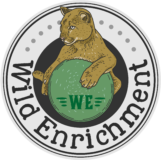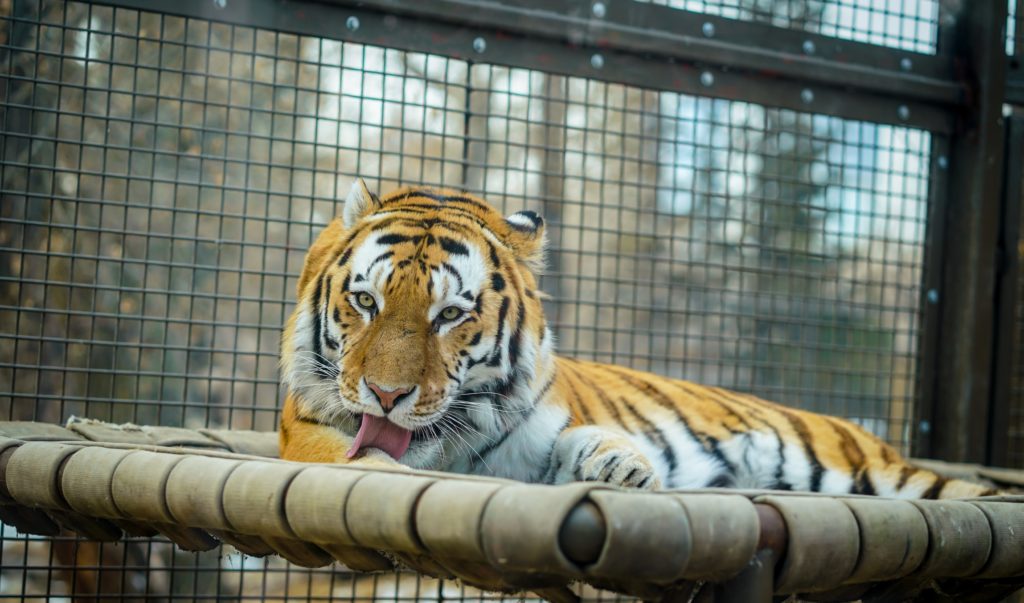For this article I will be discussing what I view as a “behavioural husbandry overview” for felids. This article will include the various forms of felid enrichment and training that can be used effectively on felids, both large and small, within a zoo setting. Felids are some of my favourite animals to work with due to their power, agility, and general willingness to play. This, combined with these other attributes really allows for a very wide breadth of effective enrichment. If you want to know more about why providing enrichment opportunities is important check out our article on What is animal Enrichment and A Modern Guide to Environmental Enrichment in Zoos and Aquariums.
Before we go into detail about effective enrichment techniques to use with felids, we must first go over their natural history. Having a solid understanding of an animal’s natural history has the potential to greatly increase the effectiveness of species specific enrichment.
For a downloadable PDF of this overview click here:
Felid Natural History
The term felid refers to the taxonomic family “Felidae” of the order Carnivora, and includes all “cat” species, large and small. This family is extremely diverse and inhabits just about every corner of the globe. Felids have several unique characteristics that make them so special, the first of them being their retractable claws and exceptional forearm power. Coupled with their strong bite power, these limbs allow them to hold onto prey with a deadly effectiveness, which is especially useful to cats due to the fact that they are all obligate carnivores (meaning they get all of their calories from prey) and generally hunt alone. Their lean muscular limbs allow them to be extremely agile and athletic, with many species being able to jump and climb with exceptional efficiency.
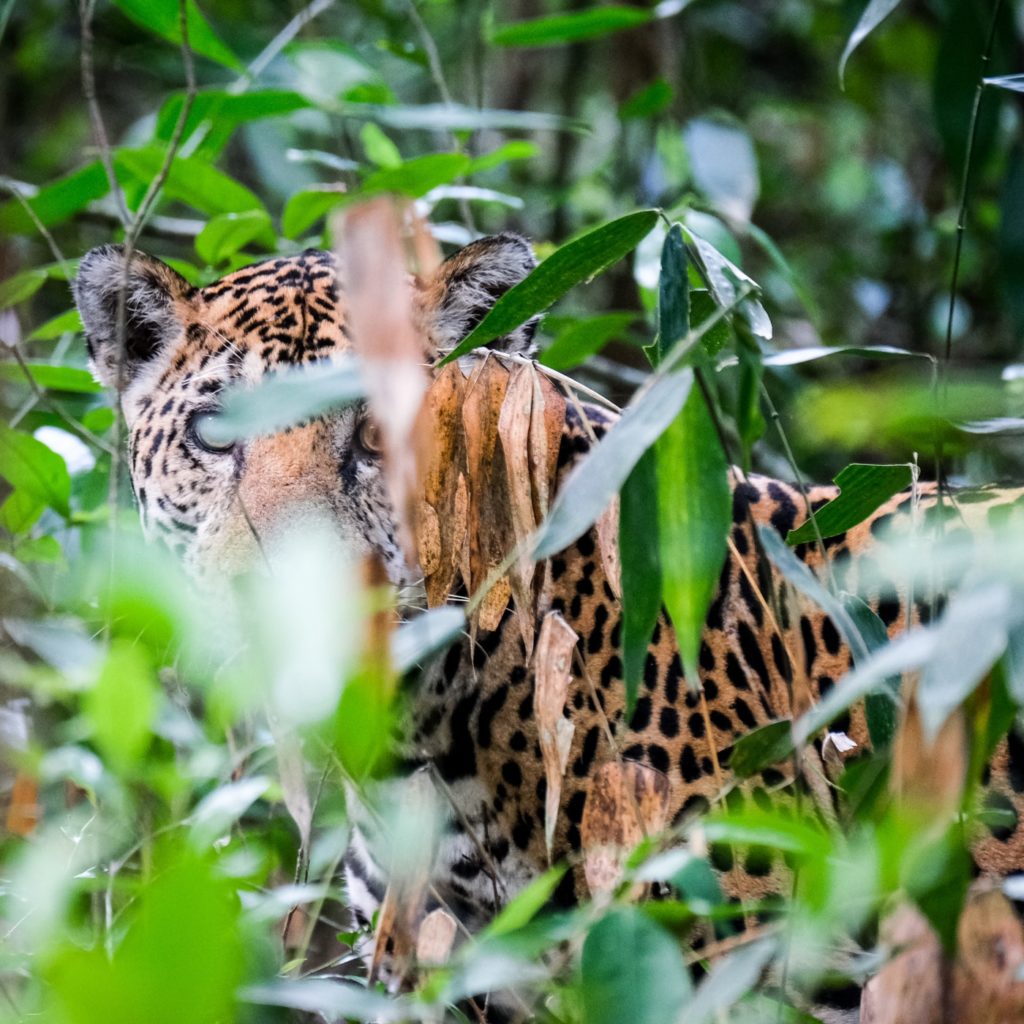
There is a tremendous amount of variation found in felids due to the physiological diversity throughout the globe. Some felids are lightweight and relatively small like the Pallas cat that relies on hunting small prey through various ambush techniques. Other felids are much larger, such as the Amur Tiger, which relies on stealth and athleticism to hunt large ungulates. Some cats like the Ocelot are completely at home in the trees whereas other cats like the Cheetah, spend most of their life on the ground.
This level of variation in physical ability and preferred feeding strategies allows for a tremendous amount of variation in enrichment. This is why it is extremely important to look into the individual species natural history when designing an enrichment program for a felid. Some things to focus on when researching a species are hunting techniques, habitat use, diet and the primary senses of each species. Hunting techniques are very important to understand as this will give you a great idea of the animals athletic ability and how you should be setting up food based enrichment; for example, a Cheetah is very well suited to the use of a high speed lure whereas a Leopard is very well adapted to climb a feed pole to get at its food. Habitat use is a very important factor to consider as well, as this will influence how the felid is able to use the features in its exhibit and how the exhibit can be designed to maximize the benefit to the animal. Finally, diet is another important factor to consider when designing enrichment for a felid, as a novel food item can make for some of the most engaging enrichment you can present to a felid.
Safety Considerations
As with any enrichment program there may be various risks involved and therefore the safety of the animal needs to be considered by as many parties as possible, including animal care staff, nutritionists, and veterinarians. Since most felids fall under the category of “dangerous animals” and will be worked in protected contact, enrichment needs to be tested and deemed safe before it is placed in the exhibit. Staff do not have the luxury of manipulating enrichment as it is being presented to the animal – as a consequence, the use of risk assessment protocols and processes must be of primary importance. Even if the enrichment is deemed safe, a plan should be put in place for how to separate the animal from the enrichment quickly if need be. Starting the enrichment in a behind-the-scenes space or with very high reward food items at the ready are all great ways to separate the animal from the enrichment in an emergency.
Another thing to consider before putting any new enrichment in with a felid is the strength and destructive power of some of these animals. This destructiveness can result in ingestion of part of any enrichment item and the potential entanglement or injury to the cat if the item is not built to withstand it. This is going to vary a lot on an individual basis – in my experience, there are cats that will eat anything soft that they can shred, and others that will shred something but are not interested in ingesting any part of it. Things like burlap or cloth, ropes and thin plastic should all have special consideration for their ingestion potential before putting it in with the cat for the first time, especially if you’re planning to leave it in an exhibit for a long period of time. As well as ingestion, entanglement or injury is something that should be considered whenever putting rope, chain or cable inside the exhibit, any forming loops should be avoided at all costs due to the high potential for entrapment.
Certain Felids’ solitary natural history and zoo-managed group housing creates challenges for the inclusion of food-based enrichment in any program. Alternatively, introducing individual animals to enrichment prior to group exposure is a great way to reduce the likelihood of fights and injury as a result of novelty. When doing food based enrichment items it is always a good idea to have multiple sources of food in the exhibit and even shifting animals out one at a time so they can get their food at their own pace without having to race another individual for it.
While all of the above are important considerations for the safe development of enrichment, they are by no means all-encompassing. Species-specific considerations can change drastically depending on the exhibit and mode of enrichment used. You and your team are the most well-versed advocates for what is and is not safe for your animal, so be sure to collaborate with your team as enrichment design progresses.
Felid Exhibit enrichment
In a zoo setting, a well designed exhibit is one of the most important aspects of a great enrichment program. The exhibit is the animals home and where it is spending its days and nights, therefore if an exhibit is poorly designed for its inhabitants, other enrichment is just acting as a bandaid for the larger problems and larger deficiencies caused by an ill suited exhibit (Maple, Perdue, 2013). There is significant research that states that the development of stereotypic behaviours is a direct result of being housed in a sub optimal environment (Swaisgood & Sheperdson, 2005). Complexity is one of the most important factors to think about when thinking about exhibit design. A complex exhibit gives an animal space and provides the opportunity for the performance of natural behaviours, challenges them, and also gives them the privacy and housing they need to feel safe and comfortable.
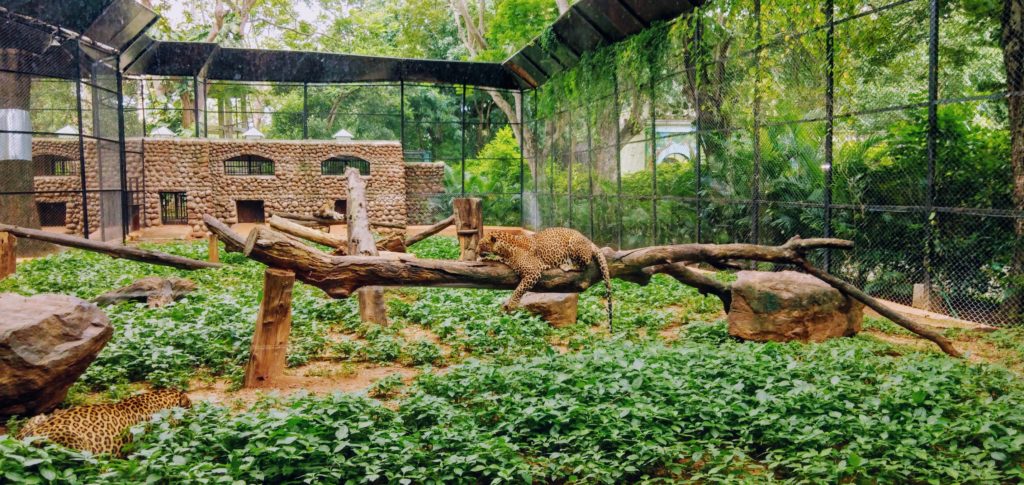
The ability to feel safe and comfortable with optional privacy is something that is often overlooked for felids, but as solitary and reclusive animals in the wild, the ability to not be seen and to get away from visitors and keepers is an important factor in a well designed felid exhibit. For solitary felids this can also apply to group housed individuals., Felids need space to get away from one another to eat and forage without the risk of getting attacked which would have the potential of causing further stress.
Many of the other aspects of exhibit complexity break down into species specific needs based on their natural history, as previously discussed. For felids that enjoy arboreal or predominantly forested environments, such as Lynx, Ocelots and Leopards, the environment should include as many opportunities to climb as the space will allow. Really take the word Complex to heart here and try to have as many spaces to climb as possible. Don’t be afraid to challenge the cat with things like hanging platforms (great for using “dead spaces” in an exhibit) and logs or perching of various thicknesses (so long as its strong enough to actually hold the cat). Depending on the height of the exhibit, try to go as high as possible with perching as well as platforms, as this will allow the cat to not only get away from people or exhibit mates but may also help them take advantage of microclimates and shade spots (Swaisgood and Shepherdson. 2005) throughout the day.
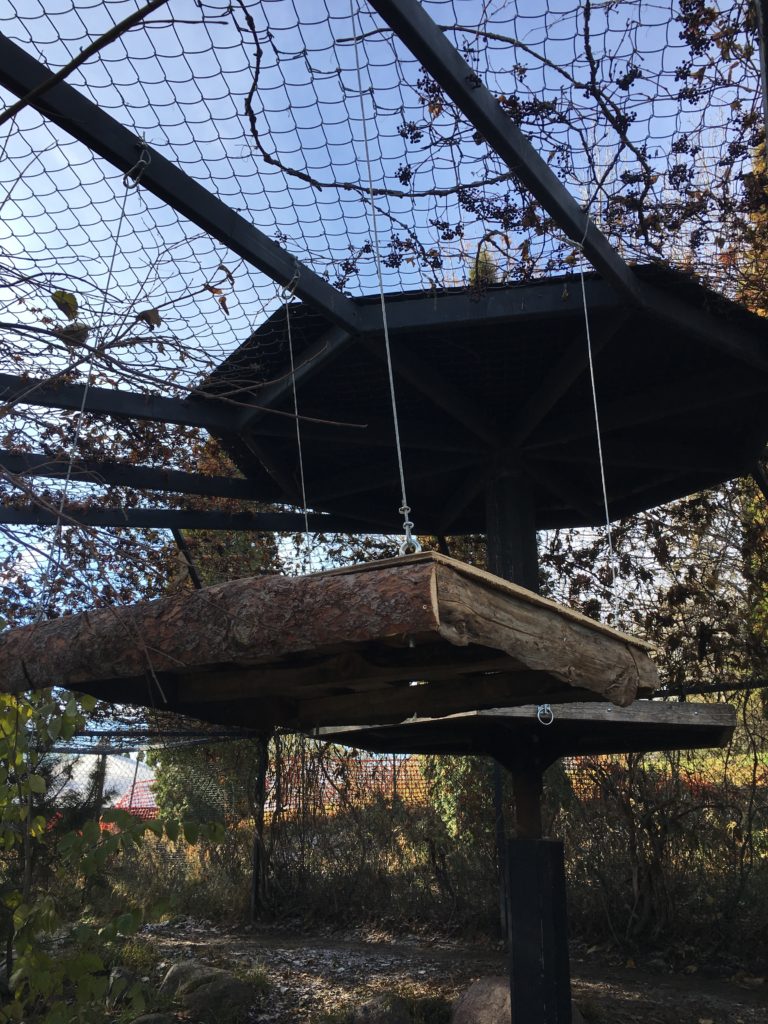
Felids that live a less arboreal life and live in open plains and savannas, such as Tigers, Servals and Cheetahs, should have more wide open spaces with more of a focus on other enrichment techniques to create complexity in their exhibit. Things like tall grasses, various substrates (for example, a mulch patch, sand patch and a straw patch) and rock structures are a great way of adding complexity to wide open exhibits. Just because these felids arent classified as arboreal in the wild does not mean they cannot climb. Even cheetahs with their non retractable claws can climb, and so it is often a good idea to make some sort of climbing structure in a portion of their exhibit for further complexity while maintaining the choice to climb or not. With these cats it’s often a good idea to limit the amount of difficulty in climbing structures until skill level and ability can be assessed on an individual basis.
Felid Tactile Enrichment/ Cognitive Enrichment
Tactile enrichment and cognitive enrichment can be a great way for captive felids to express some of their natural behaviours in a safe and reliable manner. Most species of cat are naturally curious and this can easily be taken advantage of when thinking of new and novel enrichment to give them, as they will quite often investigate and potentially play with items that they have never seen before. Things like plastic toys of various sizes are generally well received the first few times they are presented. Generally, in order for you to get a cat to consistently interact with tactile or cognitive enrichment it needs to be motivated by combining the enrichment with either food or scent enrichment. There are some exceptions to this as some cats develop an affinity for particular toys and will interact with them consistently and without any other motivation than the toy itself.
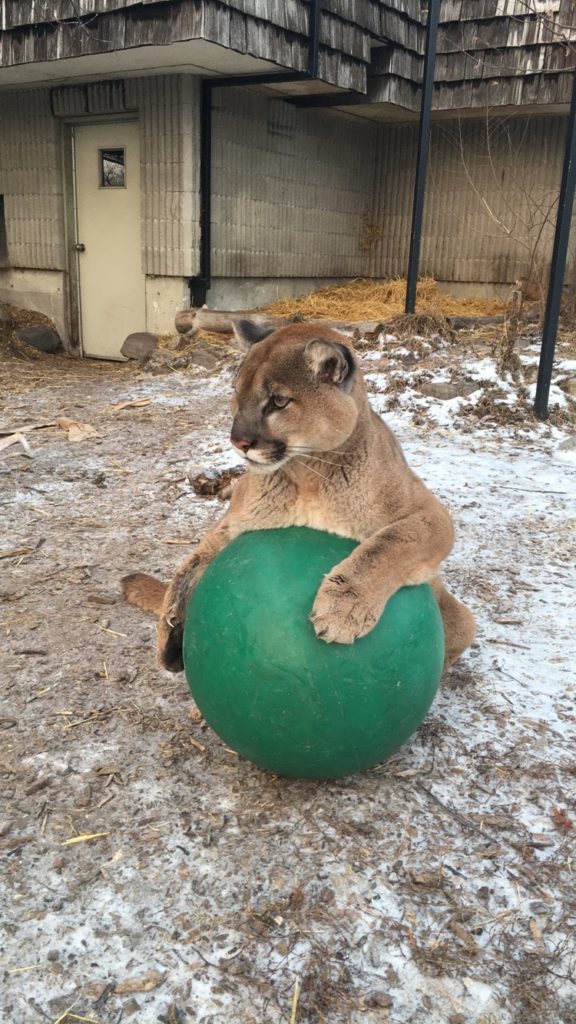
One of the biggest motivators in a felid enrichment program is stimulating their natural hunting instincts through movement of the enrichment object. A cheetah lure is a great example where they are motivated to chase it simply because they see a fast-moving object and their prey drive takes over. The use of artificial prey items (items that look like prey but contain no food value) have been proven to be an effective way of enriching felids (Markowitz and LaForce, 1987) . Cats also are very motivated to interact with enrichment they can destroy and rip apart, and this can be stimulated through providing them with safe materials to do so., Items such as cardboard boxes (which also make great enrichment shelters), burlap sacks filled with substrates (be aware of the potential for ingestion) and paper bags/ other paper products. Felids also like to scratch (as it is a way of scent marking), so providing them with ample opportunities to do this is important. This marking behavior can be achieved by putting new logs in their exhibit or building them with dedicated scratching posts that are left bare, or covered with hemp rope. The use of large-diameter and previously used browse can add complexity with minimal input by adding prey scents along with the novel post.
Felid Olfactory Enrichment
Almost all felid species have an amazing sense of smell and olfactory enrichment can often be extremely successful with very little effort on the part of animal care staff. Some great ways to provide olfactory enrichment is to place things like various herbs , spices and diluted oils around when you are servicing the cats exhibit. Another great way to provide olfactory enrichment is to also use various perfumes and colognes (these can be donated from staff or visitors) around their exhibit. There are a few perfumes and colognes in particular that elicit the best responses, such as the well documented, Calvin Klein Obsession, (Cove et al, 2014). If your facility allows it, feces, fur and hoof trimmings from various prey species are often a hit with cats as well, but should be presented in consultation with veterinary approvals to ensure there is no hazard of cross contamination. All of these olfactory enrichment techniques we have discussed here can easily be combined with tactile or food based enrichment to increase their effectiveness.
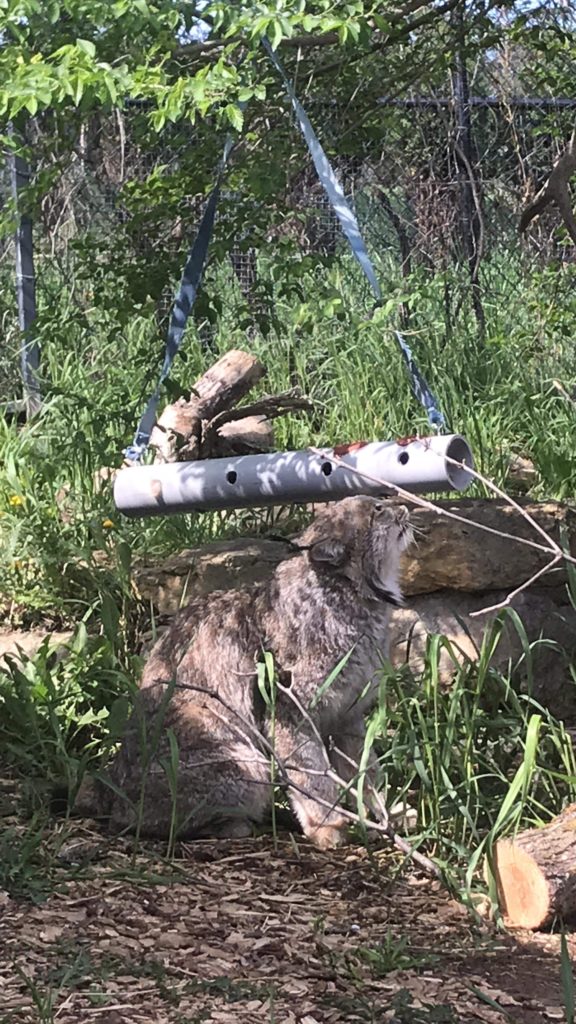
Food based Felid enrichment
Food based enrichment is an incredibly important enrichment strategy when designing an enrichment program for a felid. In the wild many cat species have extremely low hunting rate success (Hayward et al, 2006) and can spend up to half their day hunting for food. It is due the sheer volume of hunts that their wild counterparts are partaking in every single day, that I believe food based enrichment is so successful at providing effective enrichment for many felid species in captivity. The first factor to think about with food based enrichment is the frequency at which the cat is being fed. One feed per day maynot be enough to provide adequate “hunting” opportunities. Although many large cats only make a kill once or twice a week in the wild (Miller et al ,2013). I believe more frequent, smaller meals throughout the day will allow for more food based enrichment opportunities to provide the cat throughout the day, especially if the cat is already getting fed every single day (these frequent meals could be balanced with more fast days or a varied feed schedule, consult nutrition staff before implementing). Not only could you provide the cat with multiple feedings a day, but you could also randomize their feeding schedules as well as the method in which the food is delivered to them in order to further decrease predictability.
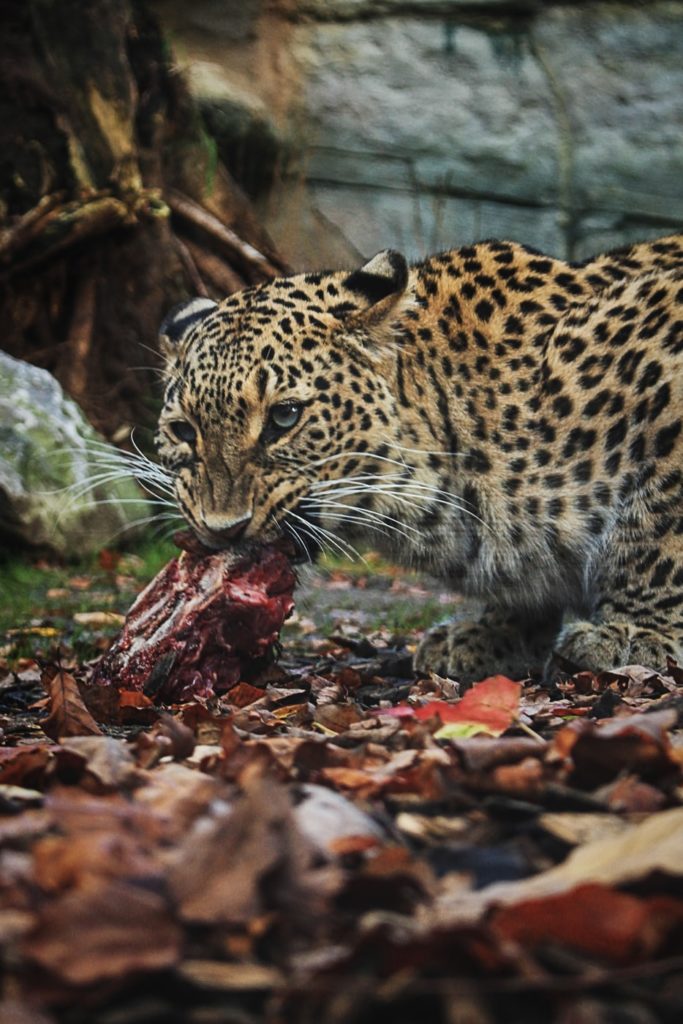
Food based enrichment is really where you get to try to bring out the amazing hunting behaviours and techniques out of the animal you’re trying to enrich. As mentioned in the beginning of this article, the hunting techniques and athleticism of a cat is going to vary tremendously between species and therefore so will the food based enrichment that you can offer them. Cats such as snow leopards, lions, and tigers that rely on their incredible athleticism to catch their prey, can have food enrichment that encourages very high jumping, climbing difficult obstacles and impressive feats of strength to acquire their food.
A great enrichment device for particularly athletic cats, as well as a variety of other felid species is an enrichment zip line. Placing a zip line in an exhibit allows you to secure food to the line at various heights and through various methods of securement.This line gives you the ability to secure food to open areas of the exhibit that would otherwise be impossible to secure things to. For example, a zip line could be placed 10 feet off the ground and a whole prey item such as a chicken or rabbit could be secured using a carabiner or a quick link, this would force the cat to jump for its food. This difficulty can also be increased with the method of securement – securing the food item through a bone or a tendon instead of flesh can greatly increase the amount of force needed to release the food item from the zip line. Zip lines can also be placed above trees or combined with exhibit features in order to make the cat use exhibit features to get at the food.This creating single-path enrichment systems to get access to the whole prey can engage felids in a high level of cognitive enrichment. Zip lines present the relationship between an obstacle and the ultimate food reward without necessarily having to teach new behaviours, which can be extremely rewarding for both keeper and animal.
Another great example of food Another great example of food based felid enrichment is a feed pole. This is basically a tall pole secured into the ground of the cats exhibit, that food items can be placed on top of, much the same as a zip line. This great enrichment device allows felids to use their muscles/ musculature to haul themselves up the pole in order to get at their food. With thoughtful design, feed poles can be used to steadily increase the strength and stamina of a felid with increasing heights. Poles can be put at various angles in order to make them less difficult to climb, and therefore can accommodate use by a variety of species.
Another factor to consider when thinking of food based enrichment for a felid is that many species of cat have a natural instinct to relocate their food to a safer location after they have made a kill in order to protect it from other predators (Stein et al, 2015). This behaviour can be used to the animal care staff’s advantage by securing food items to various parts of the exhibit with the use of bungees and chains (be aware of the possibility of potential limb entanglement, and design enrichment to eliminate this risk accordingly). For example chaining the food item to the bottom of a tree or another exhibit feature will generally make the cat fight and rip at the food item until it is free to take it to a spot to feed. As mentioned before, this can be made more difficult by securing the food item with a quick link though a tendon or a bone of the food item.
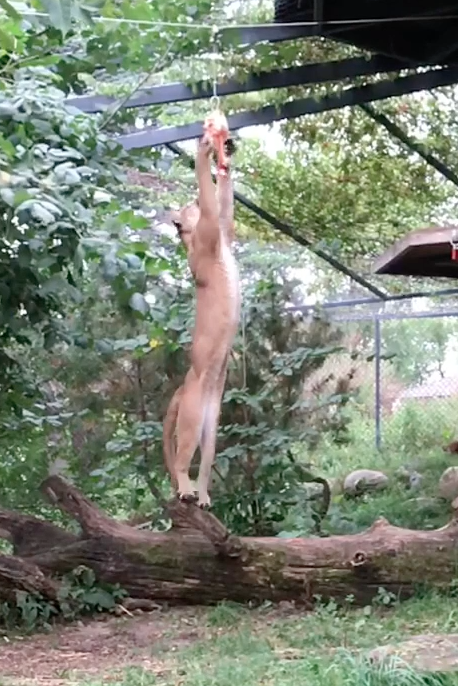
The term “food item” has been used several times throughout this enrichment guide. Food itself, and the novelty or unique characteristics (taste, texture, smell, shape) presents copious enrichment opportunities in and of itself. The use of whole prey items as well as carcass feedings, has been found to greatly increase several welfare markers in felids including: increased time spent feeding, greater possessiveness over food items, improved appetite, and even improved oral health (Bond and Lindburg, 1990). Based on these positive welfare indicators, it is clear that every felid enrichment program should attempt to include some form of carcass feeding whenever possible.
It is very important to be as creative as possible when trying to think of ways to simulate hunting scenarios in felids by combining their drive for food and as many senses as possible. A study conducted by Markowitz, Hal. Aday, Cheyl and Gavazzia. (1995), took a computerized system to produce bird sounds in the exhibit of a leopard and rewarded the leopard for finding the “bird” with various bird parts, thus creating a game where the leopard had to use its sense of hearing to hunt the bird sounds. This game is a creative example of food based cognitive enrichment and has the potential to reduce stereotypic behaviours and increase foraging time.
Contrafreeloading
Contrafreeloading is a psychological phenomenon that occurs when an animal is offered free food and food that it has to work for, and prefers the food that it has to work for. For a more in-depth analysis of the science behind contrafreeloading, please refer to our article “Contrafreeloading is Zoos and Aquariums”. Due to their hunting instinct as well as their feeding habits, most felid species make great candidates for incorporating contrafreeloading into their behavioural husbandry programs.
As previously mentioned, many wild felids can spend the majority of their waking hours hunting for their next meal, the satisfaction of this core behavioural driver is paramount to providing proper welfare in a captive setting. Increasing the number of feedings, decreasing the amount of food they aren’t working for, and using a multitude of food based enrichment items can help increase foraging time in captive felids. A combination of food based enrichment and an understanding of contrafreeloading will help make any felid enrichment program a success. The use of natural history again steers the conversation around foraging – wild data is essential in orienting time budgets towards true-to-life hunting styles in managed felids. To begin contrafreeloading, slowly decrease the total amount of food that the cat is getting for free and instead, place this free food in various enrichment items. This has the potential to increase foraging time, appetite and overall welfare.
Training
Training is an incredibly important part of any felid enrichment program due to the fact that training specific behaviours can greatly increase welfare markers by increasing the choice the cat has in its day to day life. Training basic husbandry behaviours are very important as many felid species will be required to shift into a holding while its exhibit is being serviced and food is being put out/ enrichment being set up. Medical based behaviours, such as voluntary blood draws and voluntary injections, can make procedures significantly less frequent and also less stressful due to the fact that they wouldn’t need to be darted. Other behaviours are going to vary facility to facility, and are going to be prioritized based on the situation, but at the very least, shifting behaviours and basic medical behaviours should be prioritized. For more information on training as part of an enrichment program, check out our article “Using Training as an Enrichment Tool”.
Felid Enrichment Ideas
Exhibit Enrichment
- Hanging Platforms and other hanging perching/ furniture
- Perching and Climbing Structures
- Trees and logs throughout
- Platforms at various elevations
- Several “privacy areas”
- Patches of long grass
- Various substrate piles
- Rock structures
- Caves and “denning” areas
Tactile/ Cognitive Enrichment
- Large plastic balls/ Other novel plastic toys
- Cardboard boxes and other cardboard products
- Burlap sacks and other shreddable fabrics
- Plastic barrels and Jugs
- New exhibit furniture/ frequent change ups
- PVC toys/ enrichment
- Lures
- Artificial prey items
- Feathers
- Tires
Olfactory Enrichment
- Snake skins
- Feces or urine from a prey species
- Leaves, pine cones
- Herbs and spices
- Perfumes and colognes
- Aromatic oils and extracts
- Bedding/ substrates from other species
- Fruits and other novel non-dietary items
- Antlers, hoof trimmings and hair from other species
Food based Enrichment
- Zip line
- Feed pole
- PVC toys
- Plastic toys that can hold food
- Carcass feedings
- Scatter feedings
- Food item secured to another item or exhibit
- Boxes and paper bags full of food
Other Enrichment
- Music
- Prey sounds/ distress calls
Enrichment Tracking
Based on all of the above topics, it is clear that when building a successful felid enrichment program, tracking several important metrics is very important for goal setting and rating overall effectiveness. Things like foraging time, percentage free food and the type of enrichment being used are all very important. For an example of an effective enrichment tracking system, check out these resources:
Want Help Designing a Felid Enrichment Program?
References
Maple, Tery and Perdue, Bonnie. 2013. Issues Regarding Enrichment. Zoo Animal Welfare.
Swaisgood, Ronald and Shepherdson, David. 2005. Scientific Approaches to Enrichment and Stereotypies in Zoo Animals: What’s Been Done and Where Should We Go Next? Zoo Biology 24:499–518
AAZK Animal Welfare Committee. Suggested Guidelines for Carnivore Enrichment. AAZK.org Available: https://s3-us-east-2.amazonaws.com/aazkorg/wp-content/uploads/20180626152051/Suggested-Guidelines-for-Carnivore-Enrichment.pdf
Litchfeild, Carla et al. 2017. The ‘Feline Five’: An exploration of personality in pet cats (Felis catus). Plos One. Available: https://doi.org/10.1371/journal.pone.0183455
Markowitz, Hal and LaForce, Shirley. 1987. Artificial prey as behavioral enrichment devices for felids. Applied Behaviour Science. 18:31-43.
Cornell feline health centre. 2018. felid Behavior Problems: Destructive Behavior. Cornell University College of Medicine. Available: https://www.vet.cornell.edu/departments-centers-and-institutes/cornell-felid-health-center/health-information/felid-health-topics/felid-behavior-problems-destructive-behavior
Hayward et al. 2006. Prey preferences of the leopard (Panthera pardus). Journal of Zoology. Available: https://doi.org/10.1111/j.1469-7998.2006.00139.x
Miller et al. 2013. Estimating Amur tiger (Panthera tigris altaica) kill rates and potential consumption rates using global positioning system collars. Journal of Mammalogy. 94:845-855
Bond, Julie and Lindburg, Donald. 1990. Carcass feeding of captive cheetahs (Acinonyx jubatus): the effects of a naturalistic feeding program on oral health and psychological well-being. Applied animal behaviour science. 26: 373-382.
Markowitz, Hal. Aday, Cheyl and Gavazzia, Anita. 1995. Effectiveness of acoustic “prey”: Environmental enrichment for a captive African leopard (Panthera pardus). Zoo Biology. Available: https://doi.org/10.1002/zoo.1430140408
COVE, Michael V.; SPINOLA, R. Manuel; JACKSON, Victoria L.; SAENZ, Joel. 2014. Camera trapping ocelots: an evaluation of felid attractants. Hystrix . 2014, Vol. 25 Issue 2, p1-4
Andrew B. Stein, Sven L. Bourquin, J. Weldon McNutt. 2015. Avoiding Intraguild Competition: Leopard Feeding Ecology and Prey Caching in Northern Botswana. African Journal of Wildlife Research. 45(2):247-257.
